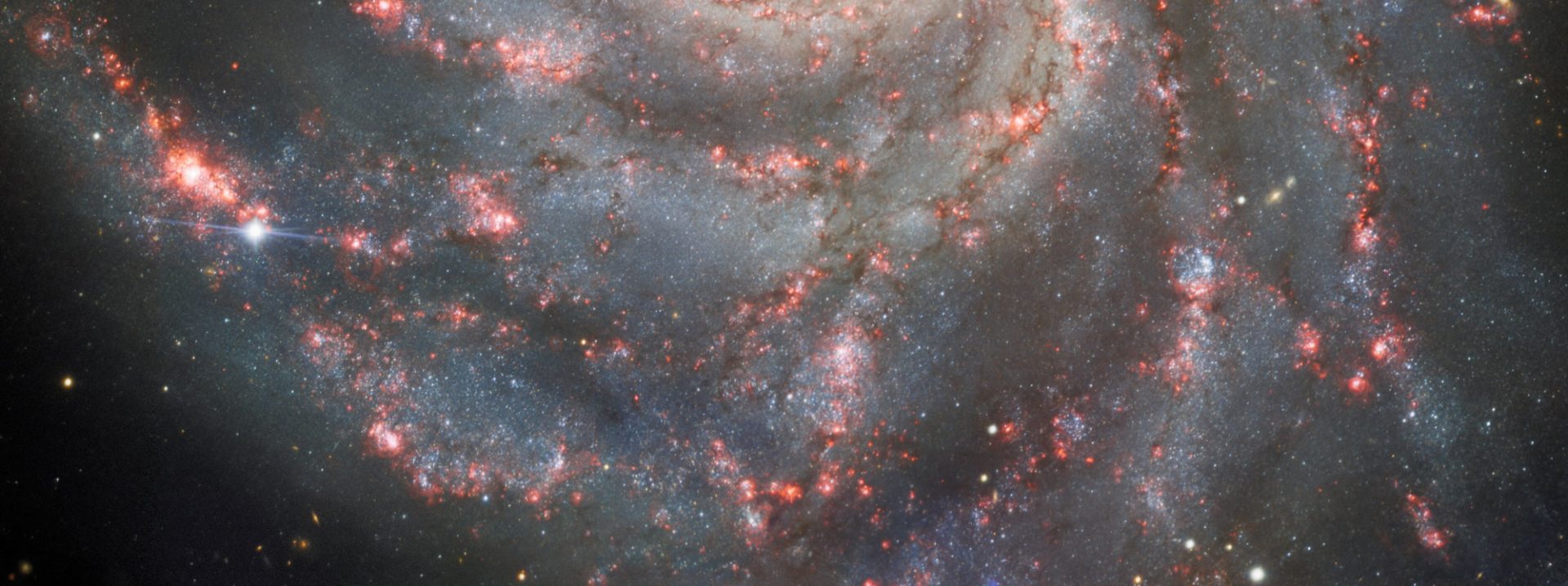POSSIBLE SUPERNOVA IN NGC 2446
Zhijian Xu(Nanjing,Jiangsu,China) and Xing Gao (Urumqi,Xinjiang,China), report the discovery of a possible supernova (mag approximately 17.9) on several 40-s survey images (limiting mag about 19.5) taken by Xing Gao in Xingming Observation Sky Survey(C42) around Mar.26.69009 UT.using an unfiltered CCD ( + Celestron C14 Schmidt-Cassegrain telescope D=356-mm @f/6.9 ). The new object approximately located at R.A.=07h 48m 44s.10 Decl.=+54°36’40”.5(equinox 2000.0). Which is about 54.8″ east and 2.4″ south of the center of the NGC 2446. Nothing is visible at this position on archival images taken on Mar.3(limiting mag 19.0),Mar.21(limiting mag 18.5), or on the DSS from Feb.25,1995(limiting mag about 19.5).
NET USNO-A2.0
XM66ZX C2014 03 26.69009 07 48 44.10 +54 36 40.5 17.9 V C42
All images can be seen from: http://www.xjltp.com/XOSS/XM66ZX/XM66ZX.htm
C42,Xingming Observatory,Mt. Nanshan. Observers Z.Xu,X.Gao,Measurers Z.Xu 0.36-m f/6.9 Schmidt-Cassegrain telescope and CCD.
Electronic Telegram No. 3845
Central Bureau for Astronomical Telegrams
INTERNATIONAL ASTRONOMICAL UNION
CBAT Director: Daniel W. E. Green; Hoffman Lab 209; Harvard University;
20 Oxford St.; Cambridge, MA 02138; U.S.A.
e-mail: cbatiau@eps.harvard.edu (alternate cbat@iau.org)
URL http://www.cbat.eps.harvard.edu/index.html
Prepared using the Tamkin Foundation Computer Network
SUPERNOVA 2014ak IN NGC 2446 = PSN J07484410+5436405
Zhijian Xu, Nanjing, Jiangsu, China; and Xing Gao, Urumqi, Xinjiang,
China, report the discovery of an apparent supernova (mag approximately 17.9)
on several unfiltered 40-s CCD survey images (limiting mag about 19.5) taken
by Xing Gao in the course of the Xingming Sky Survey around Mar. 26.690 UT
using a 35.6-cm Celestron C14 Schmidt-Cassegrain telescope at Mt. Nanshan.
The new object is approximately located at R.A. = 7h48m44s.10, Decl. =
+54d36’40”.5 (equinox 2000.0), which is about 54″.8 east and 2″.4 south of
the center of NGC 2446. Nothing is visible at this position on a Digitized
Sky Survey image from 1995 Feb. 25 (limiting mag about 19.5). The variable
was designated PSN J07484410+5436405 when it was posted at the Central
Bureau’s TOCP webpage and is here designated SN 2014ak based on the
spectroscopic confirmation reported below. Additional CCD magnitudes for
2014ak: 2014 Mar. 3, [19.0 (Xu and Gao); 21, [18.5 (Xu and Gao); 27.129,
18.2 (J. Brimacombe, Cairns, Australia; remotely using a 51-cm RCOS telescope
at the New Mexico Skies observatory near Mayhill, NM, U.S.A.; image posted at
website URL https://www.flickr.com/photos/43846774@N02/13464892014/); 28.075,
17.6 (Federica Luppi and Luca Buzzi, Varese, Italy; 0.60-m f/4.6 reflector;
position end figures 44s.05, 40″.5; reference stars from PPMXL catalogue;
image posted at URL http://www.astrogeo.va.it/pub/TOCP/PSN_N2446.jpg); 28.733,
17.0 (Xu and Gao; image can be viewed via URL http://tinyurl.com/q2aqzy9);
28.827, 17.1 (Gianluca Masi, Francesca Nocentini, and Patrick Schmeer;
remotely using a 43-cm telescope near Ceccano, Italy; position end figures
44s.02, 40″.5); 28.867, V = 17.5 (Massimiliano Martignoni, Magnago, Italy;
25-cm f/10 reflector; position end figures 43s.97, 40″.8; PPMXL reference
stars); Apr. 2.130, 16.6 (Brimacombe; position end figures 44s.07, 40″.7;
image posted at URL https://www.flickr.com/photos/43846774@N02/13618556293/).
G. Terreran, L. Tomasella, S. Benetti, E. Cappellaro, N. Elias-Rosa, P.
Ochner, A. Pastorello, and M. Turatto, Osservatorio Astronomico di Padova,
Istituto Nazionale di Astrofisica, report that an optical spectrogram of PSN
J07484410+5436405 = SN 2014ak (range 340-820 nm; resolution 1.3 nm), obtained
on Mar. 31.02 UT with the Asiago 1.82-m Copernico Telescope (+ AFOSC), shows
it to be a type-Ia supernova. Adopting for the host galaxy (NGC 2446) a
radial velocity of 5668 km/s (Theureau et al. 1998, A.Ap. Suppl. 130, 333;
via NED), a good match is found with several type-Ia supernovae around few
days before B-band maximum light. An expansion velocity of about 11800 km/s
is derived from the minimum of the Si II 635-nm line. The Asiago
classification spectra are posted at URL http://sngroup.oapd.inaf.it;
classification was made via GELATO (Harutyunyan et al. 2008, A.Ap. 488, 383)
and SNID (Blondin and Tonry 2007, Ap.J. 666, 1024).
NOTE: These ‘Central Bureau Electronic Telegrams’ are sometimes
superseded by text appearing later in the printed IAU Circulars.
(C) Copyright 2014 CBAT
2014 April 5 (CBET 3845) Daniel W. E. Green
